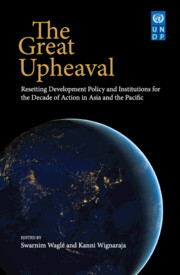Book contents
- Frontmatter
- Contents
- List of Figures
- List of Tables
- List of Boxes
- List of Appendices
- List of Abbreviations
- Foreword
- Acknowledgements
- Introduction
- 1 Aligning Sovereign Debt Financing with Climate Action in the Asia-Pacific Region
- 2 Melting Glaciers, Threatened Livelihoods: Confronting Climate Change to Save the Third Pole
- 3 Accelerating Universal Digital Connectivity
- 4 The Post-COVID-19 Future for Global Value Chains
- 5 Is Southeast Asia Falling into a Latin American–Style Middle-Income Trap?
- 6 Equality of Opportunity as a Measure of Development
- 7 Insights for Policymaking from the Multidimensional Poverty Index
- 8 COVID-19 and Human Security
- 9 Making COVID-19 Vaccine Universally Accessible
- 10 Enhancing the Provision of Global Public Goods: Ready for More Realism?
- 11 Asian-Pacific Regional Cooperation in the Post-COVID-19 Era
- 12 Pandemic Governance and Human Development: Early Lessons from Asia
- 13 Seven Lessons for Development Policy from the COVID-19 Pandemic
- About the Contributors
- Index
1 - Aligning Sovereign Debt Financing with Climate Action in the Asia-Pacific Region
Published online by Cambridge University Press: 28 February 2022
- Frontmatter
- Contents
- List of Figures
- List of Tables
- List of Boxes
- List of Appendices
- List of Abbreviations
- Foreword
- Acknowledgements
- Introduction
- 1 Aligning Sovereign Debt Financing with Climate Action in the Asia-Pacific Region
- 2 Melting Glaciers, Threatened Livelihoods: Confronting Climate Change to Save the Third Pole
- 3 Accelerating Universal Digital Connectivity
- 4 The Post-COVID-19 Future for Global Value Chains
- 5 Is Southeast Asia Falling into a Latin American–Style Middle-Income Trap?
- 6 Equality of Opportunity as a Measure of Development
- 7 Insights for Policymaking from the Multidimensional Poverty Index
- 8 COVID-19 and Human Security
- 9 Making COVID-19 Vaccine Universally Accessible
- 10 Enhancing the Provision of Global Public Goods: Ready for More Realism?
- 11 Asian-Pacific Regional Cooperation in the Post-COVID-19 Era
- 12 Pandemic Governance and Human Development: Early Lessons from Asia
- 13 Seven Lessons for Development Policy from the COVID-19 Pandemic
- About the Contributors
- Index
Summary
All my life, though some have changed,
Some forever, not for better.
—In My Life by John Lennon and Paul McCartney (1965)INTRODUCTION
A 2011 study projected that if the Asia-Pacific Region (APR) continues its upward trajectory, by 2050 it could account for more than half of global gross domestic product (GDP), trade and investment (ADB 2011). One could see this as a kind of ‘Great Re-emergence’, since the territories in the APR had accounted for this same proportion of the global economy before industrial development began in the West. Whole swaths of the APR have undergone permanent change, accompanied by corresponding disruptions and widespread adjustments in social and political arrangements.
These permanent transformations have been enabled by decades of vigorous economic growth, and these growth trends have, themselves, spawned an accelerating pattern of environmental costs, many induced by enlarged manufacturing activities, increased incomes that have in turn spurred expanded consumption baskets, and urbanization. Global climate change, interacting with the APR's achieved economic successes, threatens to increase the steepness of the climb towards development. Without the necessary course corrections in its current growth path, which has relied heavily on installing the fossil-based technology of the West's industrial dominance, development in the APR may stall sometime in this century.
This chapter argues that acting now, both as individual nations and on a regional basis, can both avert this stall and mitigate the human and economic costs of the action itself. In fact, if climate change marks out a path of technological, social and economic development, the question becomes one not of reducing costs but instead of accelerating investment in pursuit of development ambitions (UN, 2011, 2015; Stern, 2015).
The ongoing COVID-19 pandemic offers a window into the developmental and climate action issues facing countries in the APR. First, the pandemic highlights the heightened degree of interdependence among economies in the APR arising from commerce, travel, financial flows and shared geography. With its network of global value chains, the APR has more intense economic integration than other regions of the world (Baldwin, 2016). With increasing urbanization and the region's dependence on ports for trade and on food production from coastal and river-basin areas, climate change presents a clear threat to the economic model.
- Type
- Chapter
- Information
- The Great UpheavalResetting Development Policy and Institutions in the Asia-Pacific, pp. 9 - 38Publisher: Cambridge University PressPrint publication year: 2022



